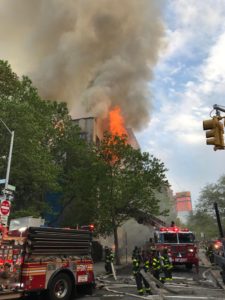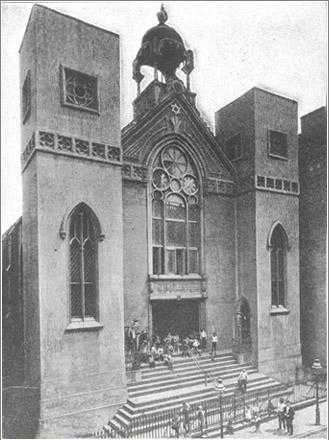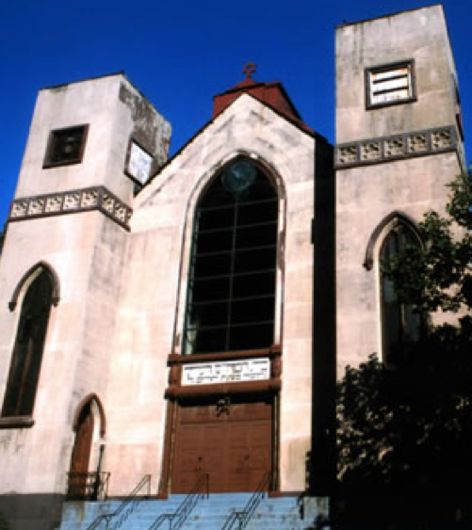Beth Hamedrash Hagadol
Remove not the ancient landmarks that thy ancestors set up, Proverb 22:28
 The sad news is that a fire that started at around 7 pm Sunday May 14, 2017 devastated the synagogue. At a July 11 hearing, the Landmarks Preservation Commission approved partial demolition with supervision by their engineering firm. On December 1, 2017, careful demolition under the supervision of the Landmarks Preservation Commission began.
The sad news is that a fire that started at around 7 pm Sunday May 14, 2017 devastated the synagogue. At a July 11 hearing, the Landmarks Preservation Commission approved partial demolition with supervision by their engineering firm. On December 1, 2017, careful demolition under the supervision of the Landmarks Preservation Commission began.
A later collapse resulted in the death of a worker and complete demolition of the building in June, 2019. Construction of an affordable 16-story senior building on the site is underway.
See our news page for the latest links.
History
This mid-nineteenth-century Gothic Revival structure was erected by a Baptist congregation that evolved into Riverside Church on the Upper West Side. Beginning in 1860, it was occupied by a Methodist church for twenty-five years. In 1885 the building was acquired by Beth Hamedrash Hagadol and remodeled as a synagogue for the nation’s oldest Orthodox Jewish Russian congregation, founded in 1852. The synagogue was recognized as a center for prayer, religious study and the interpretation of Jewish law, and had a tradition of learned rabbis. Its founder Rabbi Abraham Joseph led the way in training Jewish scholars in America. In 1899 the eminent Rabbi Jacob Joseph became its spiritual leader. The much-revered Rabbi Ephraim Oshry, religious leader of the Kovno ghetto in Lithuania and a Holocaust survivor held that position from 1952 until his death in 2003.
An interesting article, contrasting the fates of two synagogues, the Eldridge Street Synagogue and Beth Hamedrash Hagadol can be found here.

Historic Photo
The Landmarks Preservation Commission in its 1967 Designation Report noted that the rabbi and legal counsel of the congregation spoke in favor of designation and described Beth Hamedrash Hagadol as follows:
Striking in profile, this smooth-faced stone Synagogue was an interesting example of modified Gothic Revival architecture. Raised on a platform of steps above the street, the recessed center section of the symmetrical façade was flanked by square towers pierced by coupled pointed arched windows that lighted the side vestibules. The dominant feature of this structure was the main, double entrance door with over-door panel joining it to the tall tripartite arched window, surmounted by a pedimented roof, affixed with the Star of David. A handsome horizontal band of Gothic quatrefoil design met the spring of the arch of the large central Gothic window and enriched the rather plain façade. At the top of each tower was a square decorative panel of Gothic quatrefoil design.
This great Synagogue was long considered a landmark by the Greater New York Board of Rabbis, by the Union of Orthodox Congregations of the United States representing three thousand congregations and by citizens of the community. The Synagogue was noted especially for the services it had rendered to the many orthodox Jews from eastern European countries who migrated to the United States during the late Nineteenth and early Twentieth Centuries.
Congregation Beth Hamedrash Hagadol is the oldest Russian Orthodox Synagogue in the country. Founded in 1852, its first building was on Allen Street. The now-lost Synagogue was acquired June 17, 1885 from the Methodist Church and remodeled that year. The building was formerly the Norfolk Street Baptist Church, whose congregation evolved into Riverside Church on the Upper West Side. The congregation at one time had an enrollment of 1400 members and served more than 250,000 worshippers annually from the entire country. The earliest rabbi was the Russian-trained Abraham Joseph Ash, a successful manufacturer who served without pay until 1873.
The building was dedicated in January 1850 as the Norfolk Street Baptist Church. As the neighborhood changed and the city moved uptown so did the Baptists. In 1860 the Methodists purchased the church and kept possession of the property until 1885. An early print published in the New York Almanac of 1851 shows that the towers of the church originally had battlements or crenelations, which were removed from the building when it was remodeled.

Recent Photo
Sadly the structure had been damaged and neglected for years, leading to its final disgraceful condition. In the 2009 edition of her book The Lower East Side Remembered and Revisited, Joyce Mendelsohn noted:
Efforts to restore the historic synagogue, led by the Lower East Side Jewish Conservancy, have raised close to $500,000 for a feasibility study and urgent repairs. It has embarked on a major initiative for additional funds for interior structural stabilization, new mechanical systems and facilities, restoration of design elements, and adaptation of the vast structure for various uses.
All of these funds were matching grants and, since the synagogue leadership did not engage in fundraising, that effort went nowhere.
Read the Designation Report.
More information: News